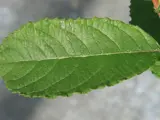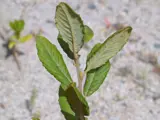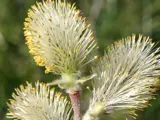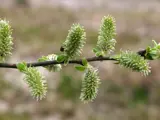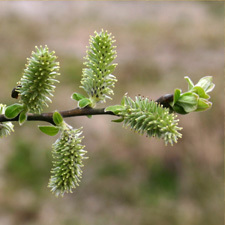 Grey willow
Grey willow
Common name: Grey willow
Botanical name: Salix cinerea
Management category: Advisory
Originally from Europe, West Asia and North Africa. It was introduced to New Zealand as an ornamental species and was recorded as naturalised in 1925.
Why is it a pest?
- Produces many, widely dispersed, short-lived seeds, grows rapidly and resprouting and suckering habit creates dense thickets.
- Replaces native species in wetlands and forms vast dense (often pure) stands and thickets.
- Causes blockages, flooding and structural changes in waterways.
Where is it found?
Stream and lake edges, river systems, wetlands and alluvial plains.
What does it look like?
- Deciduous shrub or small tree, spreading or thicket forming with suckering roots and smooth bark.
- Shoots are either grey or greenish-grey and hairy, or reddish-purple and hairless.
- Buds are reddish, and oval shaped serrated leaves are shiny on top and grey or bluish with dense, soft, grey hairs underneath which are arranged alternately on the stem.
- Erect, cylindrical catkins are produced from September to October before leaves appear, seed capsules are two-valved and contain many seeds.
What are the rules?
Advisory
Council does not enforce the control of advisory species. It is landowner/ occupier responsibility to manage these pests. Council may provide advice on how to manage or control advisory species if required.
How do you get rid of it?
- Cut and Paste (summer to autumn) – Glyphosate (spray stump) or Picloram gel (paste stump).
- Drill and fill (summer to autumn) – Glyphosate or Metsulfuron.
- Frilling (summer to autumn) – Glyphosate or Metsulfuron.
- Spray (all year) – Glyphosate or Metsulfuron.
CAUTION: When using any herbicide or pesticide, PLEASE READ THE LABEL THOROUGHLY to ensure that all instructions and directions for the purchase, use and storage of the product, are followed and adhered to.
Read more on pest control advice, information and regulations.
Images


